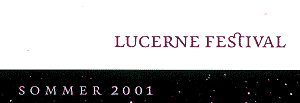
Part Two Concerts 15-26 August (PGW)
Arriving at Lucerne's lakeside, one is confronted by the sight of the extraordinary, huge cantilevered roof of the new Concert Hall, slicing through the sky and extending 45 metres diagonally, to provide cover for two cafés and an extra outdoor foyer for enjoying interval refreshments in summer evenings.
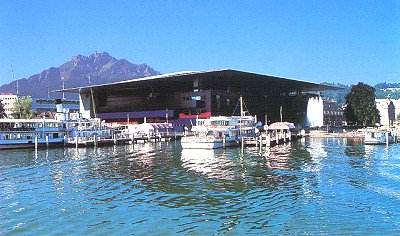
Precluded from taking his building right to the lakeside, architect Jean Nouvel decided 'if I cannot go to the water, the water shall come to me', and he channelled it to spectacular effect right into the heart of the KKL complex, with its three auditoria.
Translucent glass and aluminium grills filter light differently according to weather, time of day and angles of vision. Approached by water under a grey sky the first time we saw it, the exterior looked at first sight black and forbidding. Gradually you perceive that it is richly coloured in dark reds, deep greens and night blues. It needs several days to get to know this building, and even longer to appreciate its subtleties of styling and the discreet, unassertive finishes, which would take a whole book to describe in detail. A darkened approach to the main auditorium through light & sound locks leads to a soft white interior, with warm wood and dark blue seating. All the decorative details are intimately related to solutions of acoustic problems. Although other venues in the town are brought into use during the festival, here is its heart.
Heinz Holliger, conductor, oboist and composer
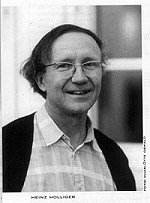
Heinz Holliger (b.1939) is held in the greatest esteem in his native Switzerland, bestriding the first weeks in his multiple roles. To open the festival he conducted a new 20th birthday tribute to the multinational Chamber Orchestra of Europe, with which he has long been associated. Following examples from the past by Schumann, Berg and Nielsen and many others, he took the names, dates of birth and personalities and skills of the current players (60% British) as his source material for the première of COncErto?.... (CertO con soli pEr tutti (perduti...?). This pièce d'occasion combines 40 little character pieces with equally whimsical titles, the whole brew designed to be stirred up by the conductor who holds up name cards to prompt the next entry and thereby keep the musicians on their toes and ensure that every performance will be different, yet 'continue to form a new whole'. The general audience at the launch of the five week festival received the bold choice of this bewildering, not-quite a concerto for orchestra warmly, showing remarkable acceptance of a patchwork-kit in a far out idiom, which elsewhere would likely have been relegated to the New Music ghetto. It was held together by the force of Holliger's personality, dancing balletically on the podium as he is wont to with his oboe, and by the unfazed instrumental virtuosity of individuals and groups taking their turns in the limelight, the whole a dazzling kaleidoscope of colour combinations destined for recording by ECM, even if possibly overlong at nearly 45 mins.
After the interval the Promethean theme which runs through the whole festival (newly renamed in English Lucerne Festival, to stress its international character) was introduced with 'something completely different', Beethoven's complete ballet score of 1802, The Creatures of Prometheus or The Power of Music & Dance, with the overture leading into storm music, the tempest raised by Zeus angered by Prometheus' divine gift of fire. The first scene is stronger than the second, save for its ubiquitous tune which Beethoven reworked in later contredanses, the variations Op 35 and the Eroica symphony. Afterwards a truly Promethean fireworks display in the Vierwaldstätter See, choreographed by Christophe Bertonneau and his Group F from Nimes to set the concert hall on fire
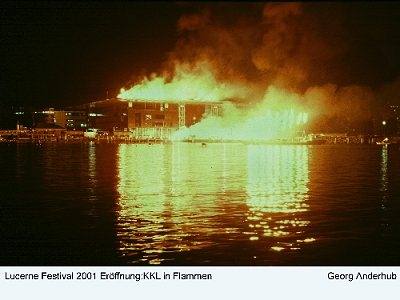 .
.
One of Heinz Holliger's most popular successes opened a concert of contemporary compositions for the multi-skilled folk musicians of Oberwalliser Spillit (Upper Valais Minstrels), performing in a folksy setting within the Lucerne Casino! Holliger's 'ghost and goblin music' Alb-Cher (1991), composed for the opening of a museum collection of Swiss folk instruments, took a macabre Valais legend, distantly related to The Soldier's Tale, about the nature of music 'which cannot be mastered with ill-will and envy'. Visually entrancing, and with new colours produced from two Swiss single-action accordions, a bowed zither, bockhornophone (marimba with deer horn resonators), tuned woodblocks and bottles, besides fiddle, bass & clarinets, it is strong enough dramatically and musically to make the CD ECM 1540 well worth exploring.
The Minstrels took their versatility even further, costumed as working Swiss peasants complete with skis and scythes, in Dream of a Slovenian tourist in theValais, a new, complex music-theatre piece without text by Vinko Globokar (b.1934) based on wonderful free-ranging fantasy. A real winner, and to our minds far more evocative than the widely-toured Battastelli work, with specially imported village artisans plying their trades; these two creations and the Valais musicians would be sure-fire sensations if they might be captured for an appearance at Huddersfield?
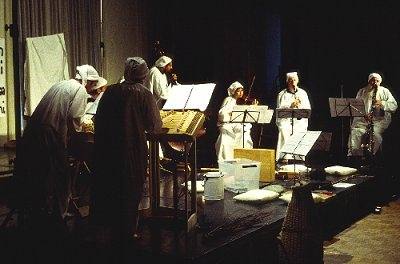
Immediately after (overlapping with the second half of the Oberwalliser Spillit concert) we were reminded again of Holliger's stature as performer by the revival of the Sándor Veress Passacaglia concertante, a substantial continuous work composed for the young oboist and premiered at the 1961 Internatiolen Musikfestwichen Luzern, as the festival was then known. Rotating through 360 degrees to use two music stands, Holliger kept the whole thing together, conducting the strings of the Camerata Bern as well as coping with the innovative and demanding solo part. Difficulties in synchronising the pizzicato chords which punctuated the central in modo d'una ballata suggested that an independent conductor might have helped in this concert, though violinist Kolja Blacher, standing at the leader's desk, ensured an invigorating and sensitive account of the Souvenir de Florence, with its finale encompassing march and tarantella, a double fugue and one of Tchaikovsky's most heart-warming tunes. Equally enjoyable, heard and seen live, was one of Zelenka's quirky concertos, Z 186 a 8 concertanti, in which individual players, violin and oboe (Holliger), cello and bassoon, took centre stage in turns with virtuosic display passages. Transferred from an outdoor venue, because of uncertain weather, this Serenade programme benefited from the adaptable acoustics of the versatile hall, lowering of the moveable canopy over the platform adding resonance and sheen to the violin tone.
Whilst many of the visiting symphony orchestras brought unimaginative programmes of standard fare, Heinz Holliger's last one during our visit offered the thoughtful programming one looks to expect at a festival. As conductor and oboist, he brought together in meaningful juxtaposition the contrapuntal musics of Bach and Carter, and two leading Swiss groups, Ensemble Contrechamps Geneve and Camerata Bern.
With the canopy lowered, the reverberation chambers fully closed for once and the sound absorbing 'rehearsal' curtains left in place, the acoustic setting was an ideal combination of clarity and intimacy, as heard and seen from a gallery, the semi-circular patterning of the stage pleasingly framing the groups of musicians centre stage, so that even a duo or a sole violinist they never appeared 'lost' in the large expanse of flooring. To my ears, this morning concert (with unnumbered seating by way of exception) was an even more impressive demonstration of Russell Johnson's acoustic achievements than the power of the full symphony orchestras.
Holliger conducted the Camerata Bern 'from the oboe' and, with Thomas Zehetmair leading, Bach's double concerto BWV 1060 was unalloyed delight, presaging a memorable morning of music making. They supported soprano Sylvia Nopper (replacing at short notice the unwell Juliane Banse, who takes the title role in the recording of Holliger's Snow Witch, ECM New Series 1715/16) in the Wedding cantata BWV 202, which did not suit her voice quite as well as Carter's daunting 1975 song cycle A Mirror on which to dwell, to six poems by Elizabeth Bishop. Hers was by far the most convincing performance I have heard of this knotty assignment, which I had never enjoyed in its earlier years, finding then the music generally rebarbative and the vocal writing ungrateful. Although it is impossible for any soprano to articulate words in the highest register, many of hers came across clearly and it was regrettable that they were not printed in full with the extensive essay in the programme. With scarcely a glance at her score, Sylvia Nopper sung this work with full commitment and a steady tone which never hardened under pressure, ending with a moving presentation of Bishop's image of lovers united by breath. I look forward to hearing her again, in A Mirror on which to dwell once more, and in songs of her own choice.
For Carter, one of the festival's featured composers, and one with whom I have had problems over the long years during which he has been such a dominant figure, this was in my book a good morning. The youthful Asko Concerto (2000) by this nonogenerian is a sprightly, eventful 12 minutes of changing relationships, giving every player the chance to shine in strongly characterised contributions, and leaving a wish to hear it straight through again (something Oliver Knussen likes to do in concert). Likewise with the duo Enchanted Preludes of 1988, a sparkling conversation piece for flute and cello. And to complete the pattern with Bach, we had heard Thomas Zehetmair (whose presentation of three solo suites straight through without pause we had admired in Barcelona) give a consummate account of that Everest of the unaccompanied violin repertoire and contrapuntal masterpiece on four strings, the Chaconne in D. Can any of our international readers confirm my belief that concerts of this type, bringing together musics of different periods with something to say to each other, were inaugurated by William Glock in his BBC Third Programme Invitation Concerts during the '60s, or was something similar afoot in other countries then, or even earlier?
Baroque Music
Bartoli & Berlin Baroque Ensemble
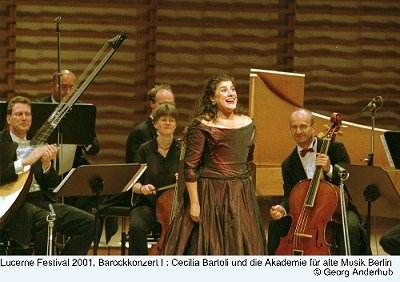
It was a delight to hear Cecilia Bartoli n the concert hall of the Lucerne Culture and Convention Centre, in her core concert repertoire of unfamiliar 18 C. opera and, after some worrying disappointments noted by Seen&Heard in London and Zurich recently, restored to full vocal health. Her confidence throughout an assignment which would have exhausted anyone else was captivating. Her tone was rich and characterful in high and low registers alike, and impeccable breath control (even though her breathing will never be inaudible) allowed Bartoli to weave long lines, which commanded silent attentiveness from a packed audience of devotees.
The first half of an over generous programme had Bartoli sing five rare Vivaldi arias, unknown save for self-quotations, such as from Winter (The Seasons) in the 11 minute Gelida from Farnace, and culminating with the 'crazy coloraturas in a terrific tempo' of Anch'il mar (Rudolf Bossard). Her selection of these, already included in a best-selling CD, encompassed 'the highest demands of an agile throat through to Baroque gravitas'. There was less obvious wooing of the audience than seen in the past and her gestures and facial expressions were wholly apt to the roles in which she briefly immersed herself before moving on to their opposites. She had a way of persuading us that the da capo repeats were integral and not just 'back to the beginning'.
Three Gluck arias from never-performed operas (Sextus' Se mai in Clemenza de Tito became O malheurese Iphigenie en Tauride!) and to be featured in a CD to be released in the autumn, prepared us for the brazen descent into the unlikely-ever-to-end encores 'demanded' by the audience's unassuageable greed and, thoughtfully, prepared by the ensemble, whose page-turning preparations made it clear when more was to follow. The ritual was punctuated by standing ovations and floral tributes from audience members, until we had heard four unidentifiable arias and songs - Cecilia's little spoken voice failed to get her introductions across in the huge hall. The most affecting were accompanied respectively by violas and solo theorbo (the latter otherwise a dominating visual presence in the continuo but little heard). Regrettably it was then back to the circus for the pyrotechnics of the final tour de force, in my book a lapse in taste after nearly 2 3/4 hours. Seemingly untired, it appeared the hyped-up diva might go on to sing all night - an effect upon her of her favourite Lucerne hall, so she has said in interview.
The Berlin players, without a conductor to stage manage the proceedings, accompanied with commendable precision and drive and contributed several instrumental items, of which I found a deliciously syncopated G minor opening allegro from Vivaldi's concerto RV 156 the most winning. This will be remembered as a great evening and a consummate demonstration of the art of 18th C. coloratura singing, my churlish strictures about its protracted conclusion not withstanding.
Having become familiar with the new Concert Hall, it was difficult, nay impossible, to come to terms with Sigiswald Kuijken and Le Petite Bande having been obliged to put up with the Jesuitkirche for their sole appearance. A glorious baroque interior, with gorgeous pink marble, was no compensation for an echoing, confused acoustic as impossible for serious listening as our cavernous St Paul's Cathedral in London. Kuijken was unassertive in manner and there was no serious attempt to compensate for the problem to project concertos by Durante and Vivaldi, one of whose concertos for two cellos was a bizarre choice, the protagonists rumbling away in the depths almost inaudibly - this is the danger of tours in which no effort is made to match repertoire to specific venues.
In the short interval, exit for a breath of air was barred 'because of a demonstration' outside! Forced to remain, the day was nearly saved by an incongruous but spirited account of Pergolesi's La Serva Padrona, with bass Antonio Abete effective as the curmudgeonly master, and Marie Kuijken (the conductor's daughter, maybe?) a sparkling, scheming servant who finds her salvation in matrimony. But the project was misconceived and lessons ought to have been learned.
Contemporary Music
We were attracted to Lucerne especially by opportunities to hear Klangforum Wien in live performance of works by Hanspeter Kyburz and Beat Furrer, known through their CD recordings previously reviewed. http://musicweb-international.com/classrev/2001/Jan01/kyburz.htm & ttp://musicweb-international.com/classrev/2000/sept00/furrer.htm The serviceable middle-sized but expandable Lucerne Hall at KKL, freely adaptable by many permutations, has a bright, rather dry acoustic which is fine for complex new music. Furrer's Still, which belies its title, is a quirky piano concerto by a joint founder of this important new music ensemble, which paid a fleeting visit to London [Classical London, #63 www.classical-london.com ] recently. Kyburz composes with computers integral to his methods, but he controls what reaches the ear with his own (as does Finland's Magnus Lindberg) and the outcome is very personal and expressive, never sterile, characteristically with a whirl of busy, superimposed lines, as demonstrated here in Parts (1995). The Voynich Cipher Manuscript, with choir, was even better heard in the round in Lucerne Hall than on the Kairos CD. There was a linguistic difficulty in the new music section of the festival as many of the works were text-based and explanatory talks and seminars were in German. This was no worry with the Voynich Manuscript, which has eluded all attempts to decipher it.
For many of his devotees, a Nono project was the high point of the time we were in Lucerne, with Prometeo revived with loving care (and a week of rehearsals) by Metzmacher, who had recorded it some years ago [EMI CDS555209-2]. The hall was completely re-jigged with ramps and balconies all around, the forces controlled by Metzmacher and Nono's one-time collaborator Andre Richard for the live electronics manipulation, plus an assistant conductor and a row of electro-acoustic technicians. Having got a good central position in the rush for seats when the auditorium was opened, it was disconcerting to discover that when it began twenty minutes later, we were to be imprisoned on uncomfortable hard chairs for a further two hours and twenty minutes without pause (with the CDs, you have to stop to change over and might even get yourself a drink!). A Lucerne critic deplored the late start and sensation of inescapability caused by being encircled by the musicians in lighting akin to a church interior - the concert hall as a place of ritual. The audience 'played along' in utter silence, soaking in sounds that remain extraordinary twenty years on.
Failing to get the message, we joined a few dissenters who made their way out some half way through, unconvinced that the elaborate apparatus deployed added up to a significant experience, or one that would reveal itself in another hour of being controlled in Cistercian silence; this is not intended to disparage Nono, rather to concede that few critics, however catholic their tastes, are without one or two blind spots or composers they are unable to relate to.
Another cult figure in the contemporary music-theatre scene is Heiner Goebbels, recently responsible for a major event at London's Almeida Festival, No Arrival, No Parking, Navigation, reported in Classical London, #63, August 2001 [www.classical-london.com] and, currently, another success Hashirigaki at Edinburgh Festival, soon coming to The Barbican.
Goebbels' music theatre contribution at Lucerne was The Liberation of Prometheus, with a text by his regular collaborator Heiner Mueller, given by Ernst Stotzner, David Moss & Heiner Goebbels himself on keyboards. This turns a more straightforward celebration of Creativity and Creation (Schöpfung) as encountered repeatedly in the rest of the festival, into a philosophical conundrum. Their brilliant use of the Prometheus myth gives pause for thought about social and cultural power-relationships. Goebbels' & Mueller's provocative questioning whether the end result justified the rescue of Prometheus confirms their ability to pull the rug from under stable-seeming assumptions and conventions, and to send musical and intellectual tables into an uncomfortable spin through both sound and speech. The Liberation of Prometheus acts as a welcome restraint and refocusing amidst the temptation to over-indulgence of musical fare. A short and breathtaking piece of music theatre.
Symphony Concerts and an acoustic experiment
The first full symphony orchestra to appear had been the Czech Philharmonic under Vladimir Ashkenazy, and impressions were mixed. From front stalls seats at the extreme right, the lower strings were full and rich, but the violins sounded glassy and harsh in the hall's revealing acoustic; later experience indicated that they are not now as good a violin section as those of several others of the orchestras to follow, but maybe a gruelling touring schedule affected this one-night stopover? La Mer was high powered but uninvolving, and Prokofiev's Cinderella music charmless - appropriately so for the memorably menacing Midnight Music. My reservations about the dry, over-bright sound from where we were seated were put into perspective by a fortuitous acoustic experiment. Scriabin's own colour plans for Prométhée, Le Poème du Feu were realised by lighting/set designer Kaisa Salmi, the lurid reds, yellows and blues of her abstract paintings projected on a gigantic, 20m x 20m screen hung in front of the orchestra, through which Ashkenazy, who had long cherished a wish to realise Scriabin's intentions, pianist Peter Jablonski, choir, huge orchestra and organist could be dimly perceived from time to time through the paintings - with the house lights up at the end they remained invisible, risibly acknowledging applause unseen! (Ashkenazy's recording of Prometheus with the LPO/Lorin Maazel is remastered on a valuable ADRM CD, Decca 417 252-2, together with the Piano Concerto & Poème de l'Extase.)
The visual novelty of Salmi's paintings was less than revelatory, failing to transform the hothouse excesses of Scriabin's score significantly. But the unsought, inestimable bonus was that the screen served ideally to soften the hall's tendency to a clinical, analytic quality noted in (only) some other concerts, moderating any harshness and adding to the sound the vital ingredients of warmth and mystery, yet without sacrificing clarity. Our seats in the Concert Hall were generally allocated in the top-price parkett (stalls) area on the main floor, but not always in the most favourable situations. However, moving to empty cheaper seats further back elicited a sharp reprimand - 'we do not change seats in Lucerne'! All concert reviews are influenced (sometimes critically) by the locations of press seats which are not always determined by acoustic considerations.
Up in the second balcony for once, the 140-strong European Union Youth Orchestra assembled from fifteen countries (parent group to the Chamber Orchestra of Europe) looked splendid arrayed below, with the young women, who predominated conspicuously, reminding one of medieval angels in dazzling sky blue (their fewer male companions attired unimaginatively in standard concert black).
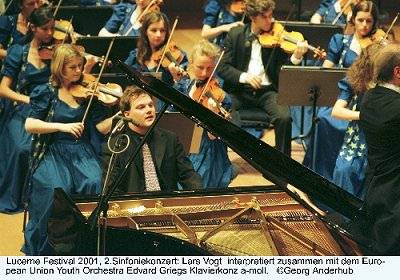
The sound too was better upstairs, in resplendent tutti or the most intimate detail, as is so in many halls. Every subtle nuance of Lars Vogt's affectionate account of the Grieg concerto came up clearly as did his Mozart sonata movement encore, and one could savour each confident solo contribution in the intricacies of Petroushka, those of flute and trumpet delivered with panache. Paavo Järvi was responsible for welding this international group of students from fifteen EUC countries into an orchestra to match any of the long established symphony orchestras on display, with the bonus that for many players these will have been their first encounters with the selected scores, ensuring freshness and a sense of wonder transmitted to listeners.
A very different symphony concert given in Lucerne's concert hall was truly revelatory. Two French symphonies, both from the 1920s, by Dupré (no. 2) and Vierne were chosen by Thomas Sauer of St. Hedwig's, Berlin, to perform on the new Goll organ, designed with a French-romantic disposition and inaugurated at last summer's festival. Vierne composed six symphonies for the spatial characteristic of Notre-Dame Cathedral and its gigantic Cavaillé-Col instrument, and rarely can his No 5 have sounded so pellucid, registers and decibels judged to a nicety with never the all too familiar, pulverising fortissimi sometimes encountered in organ recitals. The Wagnerian chromatic progressions were unconfused by excessive reverberation, every note in the passage work crystalline and clear, the scherzo fleet as quicksilver - and no sitting on final chords! Sauer knocked a further 5 mins off the scheduled 35-45 minutes we were advised it would require and, despite every demonstration of enthusiasm, disappointed by offering no encore to fill his allotted hour. This early 20 C programme was well calculated to bridge the gap between organ afficionados and orchestral concert audiences; organ music for a new century and a symphony concert to relish in the memory.
Of the main so-called 'symphony concerts' by the visiting 'big guns' particularly good memories remain of the NHK Tokyo and St Petersburg orchestras, both formidable ensemble with strength in every department. The Japanese musicians had been trained to a full understanding of western 19th & 20th C idioms under Charles Dutoit. Marta Argerich scintillated in Prokofiev under the attentively watchful eyes of Dutoit (with whom she had recorded it for EMI Classics) and a sonorous Shostakovich No 5 completed their first concert, which was balanced by a somewhat muted programme next night, which did not quite come off.
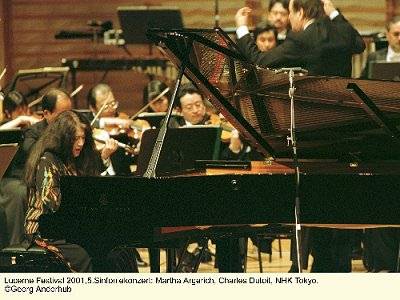
Poulenc's Gloria was to have been separated from Faure's Requiem by the Swiss novelty, xxxxxxx, but it was decided to get this (a bitter pill for some, it was maybe thought?) out of the way first - a mistake in the event and not good programming; there was too much slow, devotional choral music. The Zurich born composer Rolf Urs Ringger's Le Luci de Prometeo explored colourful instrumental sounds, but was one of those pieces which somehow seemed never to get going before it ended (I hope to receive his two CDs of his music; one should never judge a composer on a single work, which is so often all that one hears at a festival).
From the two appearances of the St Petersburg Philharmonic under the redoubtable Yuri Temirkanov, what especially remains in the mind's ear is the luscious string sound in Tchaikowsky's Nutcracker (Act 2) and the piquant characterisation of each of the deservedly famous and popular dances, never heard to better effect, and far more festive than yet another routine performance of the Bb minor piano concerto.
Authentically British
More appropriate for a major international festival were two showings of 'the best of Britain' in the 'authentic instrument' field. Traditional overture+concerto+symphony programmes were in a minority in the Symphony Concert section, but one of Mozart and Mendelssohn by John Eliot Gardiner and his Orchestre Romantique et Revolutionnaire. Although the dynamic contrast between the quietness of a fortepiano and Mozart's orchestra (quite a large one for the C minor concerto K461) remains a surprise when first heard live, at Lucerne every note of Malcolm Bilson's account came through clearly, and his embellishments of some of the lines gave added pleasure. In Scottish vein, Mendelssohn's Symphony (not a frequent concert choice nowadays) benefited from the brave unvalved trumpets and horns but even better was his Hebridean Overture Fingal's Cave, one of those miracles by an adopted Englishman and darling of the Royal establishment, who wrote many works which never cease to engage and delight, however often heard. A proper festival concert!
In Rotterdam our festival visit culminated with a great performance of Haydn's The Seasons oratorio with Dutch early music forces conducted by Sir Simon Rattle.With pleasing symmetry, at Lucerne it was the van Swieten German version of Haydn's The Creation (Der Schöpfung), in which it was premiered in Vienna, which brought to an end our visit to this great festival for which Schöpfung (Creation) was the overall theme devised to unify the disparate international offerings.
Haydn was in the very safe hands of Trevor Pinnock with The English Concert and its Choir of 34, and the well matched solo team of John Mark Ainsley, Susan Gritton and Brindley Sherratt, the latter two becoming the happy and affectionate pair, Adam and Eve in Paradise. Susan Gritton revelled in her hit-song of the time, In Verdure Clad and Sherratt's sonorous bass-baritone gave weight to Raphael's famous description of the created animals, one by one (the contrafaggotto which towered over the orchestra well in evidence). The back section of the canopy was lowered to give support to the choir, and the reverberation chambers were closed to achieve remarkable audibility throughout of the text, which celebrated God's creations with naive charm.
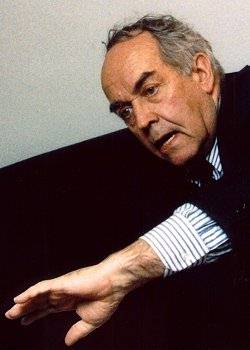
Lucerne's Concert Hall is a lovely place to sing in and listen to singing, and Russell Johnson [Lucerne 7]must have felt proud to be sitting in the stalls, unrecognised and surrounded by a contented audience; he would probably not wish it other. On this fine summer Sunday morning, with Lucerne at its loveliest, one could not help including in our gratitude the creation of this great concert hall, which must have contributed to making Haydn's vision as potent and rewarding for today's musicians and listeners as did it overwhelm those of 1798 in Vienna.
A final word about KKL's Herculean labours on behalf of Prometheus, with exemplary organisation that demonstrated the characteristic attention to detail and efficiency for which Swiss transport is deservedly famed and puts ours to shame. The illustrated programme books, which weighed in at some 3 lb for our concerts, carried English translations of the main texts. Their covers, depicting Prometheus at his labours and all emblazoned with the word SCHÖPFUNG, were identical apart from the category numbers of the individual concerts in very small print - reviewing the design for future festivals could make them easier to sort. There were also reasonably priced hard-back books, with extensive background information about the festival and its featured composers. And few are the festivals where press representatives are looked after with such care and kindness as by Regina Wohlfarth and Christian Renggli at Lucerne.
Peter Grahame Woolf
The next Festival at Lucerne is in November and will be devoted to the piano and other keyboard instruments, featuring leading international pianists. Go!
Details at
http://www.lucernefestival.ch/pdf/programm_pia2001.pdf
 Return to:
Return to: